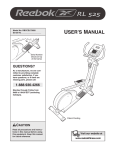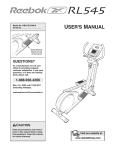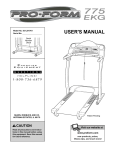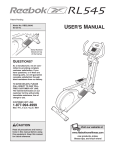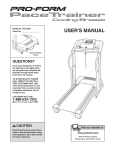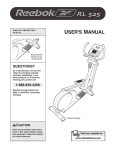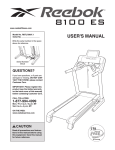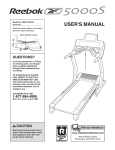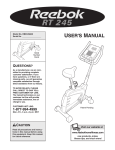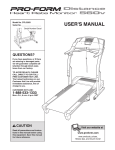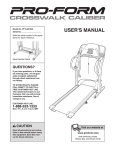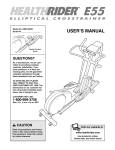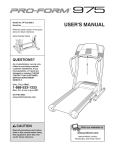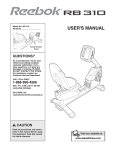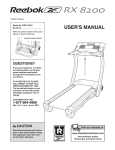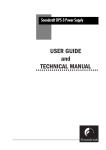Download Reebok Fitness RBCCEL79022 User's Manual
Transcript
Model No. RBCCEL79022 Serial No. USER'S MANUAL Serial Number Decal (on top of the frame) QUESTIONS? As a manufacturer, we are committed to providing complete customer satisfaction. If you have questions, or if there are missing parts, please call: 1-888-936-4266 Monday through Friday from 8h00 to 17h00 EST (excludingVisit holidays). our website at www.proform.com Visit our website at www.healthrider.com Visit our website at CAUTION www.nordictrack.com Read all precautions and instructions in this manual before using Visit this equipment. Keep this manual for future reference. our website at www.weiderfitness.com Visit our website at Visit our website at www.weslo.com Visit our website at www.jumpking.com Visit our website at www.imagefitness.com Visit our website at www.reebokfitness.com TABLE OF CONTENTS IMPORTANT PRECAUTIONS . . . . . . . . . . . . . . . . . . . . . . . . . . . . . . . . . . . . . . . . . . . . . . . . . . . . . . . . . . . . . . . .3 BEFORE YOU BEGIN . . . . . . . . . . . . . . . . . . . . . . . . . . . . . . . . . . . . . . . . . . . . . . . . . . . . . . . . . . . . . . . . . . . . . .4 ASSEMBLY . . . . . . . . . . . . . . . . . . . . . . . . . . . . . . . . . . . . . . . . . . . . . . . . . . . . . . . . . . . . . . . . . . . . . . . . . . . . . . .5 HOW TO USE THE CHEST PULSE SENSOR . . . . . . . . . . . . . . . . . . . . . . . . . . . . . . . . . . . . . . . . . . . . . . . . . .10 ELLIPTICAL EXERCISER OPERATION . . . . . . . . . . . . . . . . . . . . . . . . . . . . . . . . . . . . . . . . . . . . . . . . . . . . . . .12 MAINTENANCE AND TROUBLESHOOTING . . . . . . . . . . . . . . . . . . . . . . . . . . . . . . . . . . . . . . . . . . . . . . . . . . .26 EXERCISE GUIDELINES . . . . . . . . . . . . . . . . . . . . . . . . . . . . . . . . . . . . . . . . . . . . . . . . . . . . . . . . . . . . . . . . . . .27 PART LIST . . . . . . . . . . . . . . . . . . . . . . . . . . . . . . . . . . . . . . . . . . . . . . . . . . . . . . . . . . . . . . . . . . . . . . . . . . . . . .29 EXPLODED DRAWING . . . . . . . . . . . . . . . . . . . . . . . . . . . . . . . . . . . . . . . . . . . . . . . . . . . . . . . . . . . . . . . . . . . .30 ORDERING REPLACEMENT PARTS . . . . . . . . . . . . . . . . . . . . . . . . . . . . . . . . . . . . . . . . . . . . . . . . . .Back Cover LIMITED WARRANTY . . . . . . . . . . . . . . . . . . . . . . . . . . . . . . . . . . . . . . . . . . . . . . . . . . . . . . . . . . . . . .Back Cover REEBOK and the Vector Logo are registered trademarks and service marks of Reebok. This product is manufactured and distributed under license from Reebok International. 2 IMPORTANT PRECAUTIONS WARNING: To reduce the risk of serious injury, read the following important precautions before using the elliptical exerciser. 1. Read all instructions in this manual before using the elliptical exerciser. 11. If you feel pain or dizziness while exercising, stop immediately and begin cooling down. 2. It is the responsibility of the owner to ensure that all users of the elliptical exerciser are adequately informed of all precautions. 12. The pulse sensor is not a medical device. Various factors, including the user's movement, may affect the accuracy of heart rate readings. The pulse sensor is intended only as an exercise aid in determining heart rate trends in general. 3. The elliptical exerciser is intended for in-home use only. Do not use the elliptical exerciser in a commercial, rental, or institutional setting. 13. When you stop exercising, allow the pedals to slowly come to a stop. The elliptical exerciser does not have a free wheel; the pedals will continue to move until the flywheel stops. 4. Place the elliptical exerciser on a level surface, with a mat beneath it to protect the floor or carpet. Keep the elliptical exerciser indoors, away from moisture and dust. 5. Inspect and properly tighten all parts regularly. Replace any worn parts immediately. 14. The decal shown at the right has been placed on the elliptical exerciser in the indicated location. If the decal is missing or illegible, please call our Customer Service Department toll-free at 1-888-9364266, Monday through Friday, 8h00 until 17h00 Eastern Time (excluding holidays), and order a free replacement decal. Apply the replacement decal in the location shown. 6. Keep children under age 12 and pets away from the elliptical exerciser at all times. 7. The elliptical exerciser should not be used by persons weighing more than 115 kg (250 lbs.). 8. Wear appropriate exercise clothing when using the elliptical exerciser. Always wear athletic shoes for foot protection. 9. Always hold the handlebar when mounting or dismounting the elliptical exerciser. Always hold the handlebar or the upper body arms when using the elliptical exerciser. 210125 10. Keep your back straight when using the elliptical exerciser; do not arch your back. WARNING: Before beginning this or any exercise program, consult your physician. This is especially important for persons over the age of 35 or persons with pre-existing health problems. Read all instructions before using. ICON assumes no responsibility for personal injury or property damage sustained by or through the use of this product. 3 BEFORE YOU BEGIN Congratulations for selecting the new REEBOK® RL 725 elliptical exerciser. The RL 725 elliptical exerciser is an incredibly smooth exerciser that moves your feet in a natural elliptical path, minimizing the impact on your knees and ankles. And the unique RL 725 features adjustable resistance and a state-of-the-art console to help you get the most from your exercise. Welcome to a whole new world of natural, ellipticalmotion exercise from REEBOK. tions after reading this manual, please call our Customer Service Department toll-free at 1-888-9364266, Monday through Friday, 8h00 until 17h00 Eastern Time (excluding holidays). To help us assist you, please mention the product model number and serial number when calling. The model number is RBCCEL79022. The serial number can be found on a decal attached to the elliptical exerciser (see the front cover of this manual for the location of the decal). For your benefit, read this manual carefully before you use the elliptical exerciser. If you have ques- Before reading further, please familiarize yourself with the parts that are labeled in the drawing below. Bookrack Upper Body Arm Fan Console Handlebar with Pulse Sensor Water Bottle Holder* FRONT Upright Pedal Cushion Wheel Pedal Pedal Leg BACK RIGHT SIDE Leveling Foot *No water bottle is included 4 ASSEMBLY Place all parts of the elliptical exerciser in a cleared area and remove the packing materials. Do not dispose of the packing materials until assembly is completed. In addition to the included tools, assembly requires an adjustable wrench mallet . and a rubber Use the part drawings below to identify the small parts used in assembly. The number in parenthesis below each drawing refers to the key number of the part, from the PART LIST on page 29. The second number refers to the quantity used in assembly. Note: Some small parts may have been pre-assembled for shipping. If a part is not in the parts bag, check to see if it has been pre-assembled. M6 Split Washer Small M8 M10 Split Torque Washer (72)–2 Washer (71)–2 Washer (103)–4 (101)–2 M10 Nylon Locknut (85)–4 M6 x 16mm Button Screw (93)–2 M4 x 16mm Self-tapping Screw (82)—6 M4 x 19mm Screw (92)–2 Large M8 Washer (70)–2 M4 x 25mm Screw (96)–2 M8 x 25mm Patch Screw (73)–10 M8 x 19mm Button Screw (81)–4 Pedal Arm Spacer (65)–4 M6 x 20mm Screw (75)–4 M8 x 19mm Shoulder Screw (102)–2 Bolt Set (67)–2 1. Identify the Front Stabilizer (63), which has Wheels (27) attached to one side. Attach the Front Stabilizer to the front of the Frame (1) with four M8 x 25mm Patch Screws (73). 1 73 73 73 63 27 5 1 2. Attach the Rear Stabilizer (24) to the rear of the Frame (1) with four M8 x 25mm Patch Screws (73). 2 1 73 73 24 3. Remove the four M10 Nylon Locknuts (85) and the four M10 Split Washers (103) from the welded bolts near the front of the Frame (1). 3 While a second person holds the Upright (2), connect the Upper Wire Harness (15) to the Lower Wire Harness (39). 85 2 Align the holes in the bracket on the lower end of the Upright (2) with the welded bolts on the Frame (1). Lower the Upright, feeding the Upper Wire Harness (15) and the Lower Wire Harness (39) up into the Upright, until the welded bolts are fully inserted into the bracket. Be careful to avoid pinching and damaging the Wire Harnesses. 103 Be careful to avoid pinching and damaging the Wire Harnesses (15, 39) during this step. Bracket 15 Place the four M10 Split Washers (103) onto the welded bolts on the Frame (1). Tighten the four M10 Nylon Locknuts (85) onto the welded bolts. 39 1 Welded Bolts 4. Feed the Upper Wire Harness (15) up through the indicated hole in the Console Bracket (3). Attach the Console Bracket to the Upright (2) with four M8 x 19mm Button Screws (81). Be careful to avoid pinching and damaging the Upper Wire Harness. 4 81 3 Attach the Water Bottle Holder (13) to the Upright (2) with two M4 x 19mm Screws (92). Note: The water bottle holder is designed to be used with your own water bottle. Hole 15 2 13 92 6 5. While another person holds the Handlebar (4) near the Upright (2), feed the Pulse Sensor Wire (14) into the Upright and out of the indicated hole in the Console Bracket (3). Attach the Handlebar to the Upright with two M6 x 16mm Button Screws (93) and two M6 Split Washers (72). Be careful to avoid pinching and damaging the Pulse Sensor Wire. 5 3 93 Hole 72 14 2 4 6. Insert the Bookrack (7) into the slots in the Console (8). Attach the Bookrack to the Console with two M4 x 25mm Screws (96). Be careful to avoid pinching and damaging the wires in the Console. 6 7 8 96 7. While another person holds the Console (8) near the Console Bracket (3), connect the Pulse Sensor Wire (14) and the Upper Wire Harness (15) to the corresponding wires on the Console. 7 8 Insert all excess wiring down into the Upright (2). Attach the Console (8) to the Console Bracket (3) with four M4 x 16mm Self-tapping Screws (82). Be careful to avoid pinching and damaging the Pulse Sensor Wire (14) and the Upper Wire Harness (15). Console Wires 82 15 14 3 2 7 82 8. Insert the Pivot Axle (21) into the Upright (2), and center the Pivot Axle. Apply a small amount of the included grease to both ends of the Pivot Axle. 8 2 Identify the Left Upper Body Arm (5), which is marked with a decal. Insert an Upright Bushing (20) into an Upright Spacer (19). Turn the Upright Spacer so that the semicircular cutout is at the top, and slide the Upright Spacer onto the post on the Left Upper Body Arm. 5 20 21 19 Grease 17 16 Slide the Left Upper Body Arm (5) onto the Pivot Axle (21). Attach a Pivot Spacer (17) to the Left Upper Body Arm with an M4 x 16mm Self-tapping Screw (82). Turn a Pivot Endcap (16) so that the rectangular cutout is at the bottom. Using a rubber mallet, tap the Pivot Endcap into the Pivot Spacer. Post 71 6 102 82 Slide a Small M8 Washer (71) onto an M8 x 19mm Shoulder Screw (102), and tighten the Shoulder Screw into the Pivot Axle (21). Attach the Right Upper Body Arm (6) in the same way. 9. Apply a small amount of grease to the axle on the left Crank Arm (40). 9 Identify the Left Pedal Leg (28), which is marked with a decal. Slide the Left Pedal Leg onto the axle on the left Crank Arm (40). Next, slide a Wave Washer (101) onto the end of the axle. Then, slide a Large M8 Washer (70) onto an M8 x 25mm Patch Screw (73), and tighten the Patch Screw into the axle. 74 Grease 28 Snap a Pedal Cushion (74) around the Left Pedal Leg (28) onto a Cushion Bracket (99). Make sure that the arrow on the Pedal Cushion is pointing to one of the numbers on the Left Pedal Leg and that the number shows through the window in the Cushion Bracket. 40 99 Window 101 73 70 Assemble the Right Pedal Leg (not shown) in the same way. 10. Identify the Left Pedal Arm (33), which is marked with a decal. Attach the Left Pedal (35) to the Left Pedal Arm with two M6 x 20mm Screws (75) as shown. 10 75 35 33 Attach the Right Pedal (not shown) to the Right Pedal Arm (not shown) in the same way. 8 11. Set the Left Pedal Arm (33) on the left Pedal Cushion (74), and hold the end of the Left Pedal Arm inside of the bracket on the Left Pedal Leg (28). 11 Hold a Pedal Arm Spacer (65) between the Left Pedal Leg (28) and the Left Pedal Arm (33). Insert the long part of a Bolt Set (67) through the Left Pedal Leg, the Pedal Arm Spacer, and the Left Pedal Arm. Lift the Left Pedal Leg (28), and hold the lower end of the Left Upper Body Arm (5) inside of the bracket on the Left Pedal Arm (33). Insert the long part of the Bolt Set (67) through the Left Upper Body Arm. Hold another Pedal Arm Spacer (65) between the Left Pedal Arm and the Left Pedal Leg, and insert the long part of the Bolt Set through these parts. Tighten the short part of the Bolt Set into the long part. 5 65 32 33 65 67 67 28 Attach the Right Pedal Arm (32) in the same way. 74 12. Make sure that all parts are properly tightened before you use the elliptical exerciser. Note: Some hardware may be left over after assembly is completed. Place a mat under the exercise cycle to protect the floor or carpet. 9 HOW TO USE THE CHEST PULSE SENSOR To get the best performance from the chest pulse sensor, please read the instructions below. solution such as saliva or contact lens solution, wet both electrode areas. Return the sensor unit to a position against your chest. HOW TO PUT ON THE CHEST PULSE SENSOR CHEST PULSE SENSOR TROUBLESHOOTING The chest pulse sensor consists of two components: the chest strap and the sensor unit. Follow the steps below to put on the chest pulse sensor. If the chest pulse sensor does not function properly, or if the displayed heart rate is excessively high or low, try the steps below. • Make sure that the chest pulse sensor is worn exactly as described in step 2 at the left. If the chest pulse sensor does not function when positioned as described, move it slightly lower or higher on your chest. Chest Strap Tab Sensor Unit Sensor Unit Buckle 1 See the inset drawing above. Insert the tab on one end of the chest strap through one end of the sensor unit as shown. Then, press the end of the sensor unit under the buckle on the chest strap. 2 Wrap the chest pulse Logo sensor around your chest. Attach the free end of the chest strap to the sensor unit as described above. Adjust the length of the chest strap, if necessary. The chest pulse sensor should be under your clothing, against your skin, and as high under the pectoral muscles or breasts as is comfortable. Make sure that the logo is facing forward and is right-side-up. 3 • Each time you use the chest pulse sensor, use saline solution such as saliva or contact lens solution to wet the two electrode areas on the sensor unit (see the drawing in step 3 below). If heart rate readings do not appear until you begin perspiring, re-wet the electrode areas. • Make sure that you are within arm’s length of the console. For the console to display heart rate readings, the user must be within arm’s length of the console. • The chest pulse sensor is designed to work with people who have normal heart rhythms. Heart rate reading problems may be caused by medical conditions such as premature ventricular contractions (pvcs), tachycardia bursts, and arrhythmia. • The operation of the chest pulse sensor can be affected by magnetic interference caused by high power lines or other sources. If it is suspected that magnetic interference may be causing a problem, try relocating the elliptical exerciser. • If the chest pulse sensor still does not function properly, test the chest pulse sensor in the following way: Hold the chest pulse sensor and place your thumbs over the electrode areas as shown. Pull the sensor unit Electrode Areas away from your body a few inches and locate the two electrode areas on the inner side. Using a saline 10 Electrode Areas CHEST PULSE SENSOR CARE Next, hold the chest pulse sensor near the console. While holding one thumb stationary, begin tapping the other thumb against the electrode area at a rate of about one tap per second. Check the heart rate reading on the console. • Thoroughly dry the chest pulse sensor after each use. The chest pulse sensor is activated when the electrode areas are wetted and the chest pulse sensor is put on; the chest pulse sensor shuts off when it is removed and the electrode areas are dried. If the chest pulse sensor is not dried after each use, it may remain activated longer than necessary, draining the battery prematurely. • If the chest pulse sensor does not function properly after you have followed all of the above instructions, the battery should be replaced in the following way: Locate the battery cover on the back of the sensor unit. Insert a coin into the slot in the cover, turn the cover counterclockwise, and remove the cover. Remove the old battery and insert a new CR 2032 battery. Make sure that the battery is turned so the writing is on top. Replace the battery cover and turn it clockwise to close it. • Store the chest pulse sensor in a warm, dry place. Do not store the chest pulse sensor in a plastic bag or other container that may trap moisture. • Do not expose the chest pulse sensor to direct sunlight for extended periods of time. Do not expose the chest pulse sensor to temperatures above 122° Fahrenheit (50° Celsius) or below 14° Fahrenheit (-10° Celsius). • Do not excessively bend or stretch the sensor unit when using or storing the chest pulse sensor. CR 2032 Battery • Clean the sensor unit using a damp cloth—never use alcohol, abrasives, or chemicals. The chest strap may be hand washed and air dried. 11 ELLIPTICAL EXERCISER OPERATION HOW TO EXERCISE ON THE ELLIPTICAL EXERCISER To mount the elliptical exerciser, hold the Handlebar handlebar and step onto the pedal that is in the lowest position. Then, step onto the other Pedals pedal. Push the pedals until they begin to move with a continuous motion. Note: The pedal disks can turn Pedal Disk in either direction. It is recommended that you move the pedal disks in the direction shown by the arrow; however, for variety, you can turn the pedal disks in the opposite direction. To dismount the elliptical exerciser, wait until the pedals come to a complete stop. Note: The elliptical exerciser does not have a free wheel; the pedals will continue to move until the flywheel stops. When the pedals are stationary, step off the highest pedal first. Then, step off the lowest pedal. HOW TO USE THE UPPER BODY ARMS To add upperbody exercise to your workouts, push and pull the upper body arms as you exercise. To exercise only your lower body, hold the handlebar as you exercise. Upper Body Arms HOW TO ADJUST THE PEDAL CUSHIONS The feel of the pedals is affectPedal ed by the posiArm tions of the pedal cushions. The farther back the pedal cushions are placed, the firmer the pedals will feel. To move the Pedal Cushion pedal cushions, (under the pedal) lift the pedal arms and slide the pedal cushions to the desired positions. Make sure that both pedal cushions are in the same position. HOW TO MOVE AND LEVEL THE ELLIPTICAL EXERCISER Stand in front of the elliptical exerciser, hold the handlebar firmly, and tip the elliptical exerciser until it Handlebar can be moved on the front wheels. Carefully move the elliptical exerciser to the Wheel desired location Leveling and then lower Foot it. Due to the weight of the elliptical exerciser, use extreme caution when moving it. After the elliptical exerciser has been moved, make sure that the ends of both stabilizers are touching the floor. If the elliptical exerciser rocks slightly during use, turn one or both of the leveling feet under the front stabilizer until the rocking motion is eliminated. 12 Note: If there is a sheet of clear plastic on the face of the console, remove the plastic. FEATURES OF THE CONSOLE The advanced console offers a selection of features designed to make your workouts more enjoyable and effective. When the manual mode of the console is selected, the resistance of the elliptical exerciser and the angle of the ramp can be changed with the touch of a button. As you exercise, the console will provide continuous exercise feedback. You can even measure your heart rate using the handgrip pulse sensor. Note: For information about an optional chest pulse sensor, see page 21. The console also offers six resistance and pace programs. Each program automatically changes the resistance of the elliptical exerciser and prompts you to increase or decrease your pace as it guides you through an effective workout. In addition, the console features two heart rate programs that automatically change the resistance of the elliptical exerciser and prompt you to vary your pace to keep your heart rate near a target level as you exercise. The console also features iFIT.com interactive technology. Having iFIT.com technology is like having a personal trainer in your home. Using the included audio cable, you can connect the elliptical exerciser to your home stereo, portable stereo, computer, or VCR and play special iFIT.com CD and video programs (iFIT.com CDs and videocassettes are available separately). iFIT.com CD and video programs automatically control the resistance of the elliptical exerciser and prompt you to vary your pace as a personal trainer coaches you through every step of your workout. High-energy music provides added motivation. To purchase iFIT.com CDs and videocassettes, call toll-free 1-888-963-4266. With the elliptical exerciser connected to your computer, you can also go to our Web site at www.iFIT.com and access programs directly from the internet. Explore www.iFIT.com for more information. 13 around the track will light, one at a time, until the entire track is lit. The track will then darken and a new lap will begin. HOW TO USE THE MANUAL MODE 1 Begin pedaling to activate the console. The upper display—The upper display will show the elapsed time, the resistance level of the elliptical exerciser, your pedaling speed, and your pedaling pace (measured in minutes per mile). The display will change from one number to the next every few seconds, as shown by the indicators around the display. Note: When a program is selected, the display will show the time remaining in the program instead of the elapsed time. The elliptical exerciser requires no batteries or external power source. Power is supplied to the elliptical exerciser by a generator while you are pedaling. To activate the console, begin pedaling at a speed of about 3 miles per hour or faster. After a few seconds, the console displays will light. A tone will then sound and the console will be ready for use. 2 Select the manual mode. When the power is turned on, the manual mode will be selected. If you have selected a program or the iFIT.com mode, select the manual mode by pressing the Program Select button repeatedly until a track appears in the matrix. 3 If desired, you can select a single mode for continuous display. Press the left Mode button repeatedly until the desired mode indicator is lit; make sure that the Scan indicator is not lit. Begin pedaling and change the resistance of the pedals as desired. The lower display—The lower display will show the distance that you have pedaled and the approximate numbers of calories and fat calories you have burned (see FAT BURNING on page 27). The display will change from one number to the next every few seconds, as shown by the indicators around the display. The display will also show your heart rate when you use the handgrip pulse sensor or the chest pulse sensor. Note: Each time the resistance of the pedals changes, the display will show the resistance level. As you pedal, change the resistance of the pedals by pressing the Resistance buttons. There are ten resistance levels. Note: After the buttons are pressed, it will take a moment for the elliptical exerciser to reach the selected resistance level. Make sure to continue pedaling while changing the resistance. 4 Monitor your progress with the matrix and the two displays. If desired, you can select a single mode for continuous display. Press the right Mode button repeatedly until the desired mode indicator is lit; make sure that the Scan indicator is not lit. The matrix— When the manual mode is selected, the matrix will show a track representing 1/4 mile. As you exercise, the indicators 14 Note: The console can display speed and distance in either miles or kilometers. To find which unit of measurement is selected, you must select the console’s user mode. Hold down the Program Select button for about three seconds. The letter “E” for English miles or the letter “M” for metric kilometers will appear in the upper display. To change the unit of measurement, press the + button. When your pulse is detected, the Heart Rate indicator above the lower display will light, one or two dashes (– –) will appear in the lower display, and then your heart rate will be shown. For the most accurate heart rate reading, hold the contacts for at least 15 seconds. Note: If you continue to hold the pulse sensor, the lower display will show your heart rate for up to 30 seconds. The display will then show your heart rate along with the other modes. While the user mode is selected, press the left Mode button. The upper display will then show the total number of hours that the elliptical exerciser has been used. Press the left Mode button again. The upper display will then show the total number of miles pedaled. To exit the user mode, press the Program Select button again. 5 If your heart rate is not shown, make sure that your hands are positioned as described. Do not move your hands excessively or squeeze the metal contacts too tightly. For optimal performance, regularly clean the metal contacts using a soft cloth; never use alcohol, abrasives, or chemicals. 6 Turn on the fan if desired. To turn on the fan at low speed, press the Low button. To turn on the fan at high speed, press the High button. To turn off the fan, press the Off button. Note: The fan will operate only while you are pedaling. Measure your heart rate if desired. You can measure your heart rate using either the handgrip pulse sensor or the chest pulse sensor. Note: If you hold the handgrip pulse sensor and wear the chest pulse sensor at the same time, the console may not display your heart rate accurately. 7 When you are finished exercising, the console will automatically turn off. If the pedals are not moved for several seconds, a tone will sound, the console will pause, and the upper display will begin to flash. If there are thin sheets of plastic on the metal contacts on the handgrip Contacts pulse sensor, peel off the plastic. To measure your heart rate, hold the contacts; your palms must be resting on the upper contacts, and your fingers must be touching the lower contacts. Avoid moving your hands. If the pedals are not moved for up to one minute, the matrix and the displays will darken; however, the displays will not be reset. If the pedals are not moved for about five minutes, the console will turn off and the displays will be reset. 15 Note: If all of the indicators in the Current Segment column are lit after the resistance settings have moved to the left, the resistance settings will move downward so that only the highest indicators appear in the matrix. HOW TO USE PERSONAL TRAINER PROGRAMS 1 Begin pedaling to activate the console. See step 1 on page 14. 2 Select one of the eight personal trainer programs. The program will continue until the resistance setting for the last segment is shown in the Current Segment column of the matrix and no time remains in the program. When the power is turned on, the manual mode will be selected. To select a personal trainer program, press the Program Select button repeatedly until a “P 1,” “P 2,” “P 3,” “P 4,” “P 5,” “P 6,” “P 7,” or “P 8” appears in the lower display. Note: During the program, you can override the resistance setting for the current segment by pressing the Resistance buttons. However, when the next segment begins, the resistance will automatically change if a different resistance setting is programmed for the next segment. If you stop pedaling for several seconds, a tone will sound and the program will pause. To restart the program, simply resume pedaling. When a personal trainer program is selected, the matrix will show the first ten resistance settings of the program. 3 4 Use the console’s pace function if desired. During personal trainer programs, the console can prompt you to increase or decrease your pace as it guides you through your workout. Press the Program Start button or begin pedaling to start the program. To use the pace function, press the left Mode button repeatedly until the Pace indicator is lit; make sure that the Scan indicator is not lit. Two horizontal bars will appear in the matrix. The upper bar represents a target pace, and the lower bar represents your actual pace. During the program, the length of the upper bar will periodically change. When the upper bar changes in length, adjust your pace so that both bars are the same length. Important: The pace settings of the program are intended only to provide a goal. Your actual pace may be slower than the pace settings, especially during the first few months of your exercise program. Make sure to pedal at a pace that is comfortable for you. Each program is divided into several time segments of different lengths. One resistance setting is programmed for each segment. (The same resistance setting may be programmed for two or more consecutive segments.) The resistance setting for the first Current Segment segment will be shown in the flashing Current Segment column of the matrix. The resistance settings for the next several segments will be shown in the columns to the right. When only three seconds remain in the first segment of the program, both the Current Segment column and the column to the right will flash, a series of tones will sound, and all resistance settings will move one column to the left. The resistance setting for the second segment will then be shown in the flashing Current Segment column and the resistance of the pedals will automatically change to the resistance setting for the second segment. 16 5 pace can be proCurrent Segment grammed for each segment. The resistance setting for the first segment will be shown in the flashing Current Segment column of the matrix. To program a resistance setting for the first segment, simply adjust the resistance of the pedals by pressing the Resistance buttons. Every few times a Resistance button is pressed, an additional indicator will light or darken in the Current Segment column. To program a target pace for the first segment, simply pedal at the desired pace. Monitor your progress with the two displays. See step 4 on page 14. 6 Measure your heart rate if desired. See step 5 on page 15. 7 Turn on the fan if desired. See step 6 on page 15. 8 When the program is finished, the console will automatically turn off. See step 7 on page 15. When the first segment of the program is completed, the current resistance setting and your current pace will be saved in memory. The columns of indicators will then move one column to the left, and the resistance setting for the second segment will be shown in the flashing Current Segment column. Program a resistance setting and a target pace for the second segment as described above. Note: After the third segment is completed, the columns of indicators in the matrix will no longer move to the left. Instead, each time a segment is completed, the flashing Current Segment column will move one column to the right. If the Current Segment column reaches the right side of the matrix, when the current segment is completed all columns of indicators in the matrix will move three columns to the left. HOW TO CREATE A CUSTOM PROGRAM 1 Begin pedaling to activate the console. See step 1 on page 14. 2 Select one of the two custom programs. When the power is turned on, the manual mode will be selected. To select a custom program, press the Program Select button repeatedly until a “C 1” or “C 2” appears in the lower display. Continue exercising for up to sixty minutes. When you are finished with your workout, the resistance settings and the target pace settings that you have programmed and the number of segments completed will be saved in memory. Note: If the custom program has not yet been defined, one to three columns of indicators will be lit in the matrix. If more than three columns of indicators are lit, see HOW TO USE CUSTOM PROGRAMS on page 18. 4 When the program is finished, the console will automatically turn off. See step 7 on page 15. 3 Press the Program Start button or begin pedaling to start the program, and program the desired settings. Each custom program is divided into one-minute segments. One resistance setting and one target 17 Segment column of the matrix and no time remains in the program. HOW TO USE CUSTOM PROGRAMS 1 Note: If you stop pedaling for several seconds, a tone will sound and the program will pause. To restart the program, simply resume pedaling. Begin pedaling to activate the console. See step 1 on page 14. 2 Select one of the two custom programs. 4 See step 4 on page 16. See step 2 on page 17. When a custom program is selected, the matrix will show the first ten resistance settings of the program. Note: If only three columns of indicators are lit in the matrix, see HOW TO CREATE A CUSTOM PROGRAM on page 17. 3 Use the console’s pace function if desired. 5 Change the program if desired. If desired, you can change the program while using it. To change the resistance setting for the current segment, simply press the Resistance buttons. When the current segment is completed, the new resistance setting will be saved in memory. To change the target pace for the current segment, simply change your pedaling pace. When the current segment is completed, your pace will be saved in memory. To increase the length of the program, first wait until the program is completed. Then, press the Program Start button and program resistance settings and target pace settings for as many additional segments as desired. To decrease the length of the program, simply stop pedaling before the program is completed. If the pedals are not moved for five minutes, all unused segments will be deleted from the program. Press the Program Start button or begin pedaling to start the program. Each custom program is divided into one-minute segments. One resistance setting is programmed for each segment. The resistance setCurrent Segment ting for the first segment will be shown in the flashing Current Segment column of the matrix. The resistance settings for the next several segments will be shown in the columns to the right. 6 Monitor your progress with the two displays. See step 4 on page 14. When only three seconds remain in the first segment of the program, both the Current Segment column and the column to the right will flash, a series of tones will sound, and all resistance settings will move one column to the left. The resistance setting for the second segment will then be shown in the flashing Current Segment column, and the resistance of the pedals will automatically change to the second resistance setting that you programmed previously. 7 Measure your heart rate if desired. See step 5 on page 15. 8 Turn on the fan if desired. See step 6 on page 15. 9 The program will continue until the resistance setting for the last segment is shown in the Current When the program is finished, the console will automatically turn off. See step 7 on page 15. 18 4 HOW TO USE HEART RATE PROGRAMS Enter a target heart rate. If heart rate program 1, 2, or 3 is selected, you do not need to enter a target heart rate. Go to step 5. Each heart rate program helps you to keep your heart rate near a certain percentage of your maximum heart rate during your workout. Note: Your maximum heart rate is estimated by subtracting your age from 220. For example, if you are 30 years old, your maximum heart rate is 190 (220 – 30 = 190). If heart rate program 4 is selected, the letters “PLS” and a target heart rate will flash in the lower display. Press the + or – (Resistance) button repeatedly to change the target heart rate, if desired. Heart rate programs 1 and 3 are designed to keep your heart rate between 50% and 85% of your maximum heart rate while you exercise; heart rate program 2 is designed to keep your heart rate between 50% and 80% of your maximum heart rate; heart rate program 4 is designed to keep your heart rate near a target heart rate that you choose. 5 Hold the handgrip pulse sensor or wear the chest pulse sensor. Follow the steps below to use a heart rate program. 1 To use a heart rate program, you must hold the handgrip pulse sensor or wear the chest pulse sensor. If you use the handgrip pulse sensor, it is not necessary to hold the handgrips continuously during the program. However, you should hold the handgrips frequently for the program to operate properly. Each time you hold the handgrips, keep your hands on the metal contacts for at least 30 seconds. Note: When you are not holding the handgrips, the letters “PLS” will appear in the lower display instead of your heart rate. Begin pedaling to activate the console. See step 1 on page 14. 2 Select one of the four heart rate programs. When the power is turned on, the manual mode will be selected. To select a heart rate program, press the Program Select button repeatedly until an “Hr 1,” “Hr 2,” “Hr 3,” or “Hr 4” appears in the lower display. 3 6 Press the Program Start button or begin pedaling to start the program. Heart rate programs 1, 2, and 3 are divided into several one-minute segments. One resistance setting and one target heart rate are programmed for each segment. (The same resistance setting and/or target heart rate may be programmed for consecutive segments.) Heart rate program 4 is sixty minutes long (you may choose to use only part of the program). The same resistance setting and target heart rate are programmed for the entire program. Enter your age. After a heart rate program is selected, the word “AGE” and the current age setting will flash in the lower display. You must enter your age to use a heart rate program. If you have already entered your age, press the Enter (Program Start) button and go to step 4. If you have not entered your age, press the + or – (Resistance) button repeatedly to enter your age, and then press the Enter button. Note: Once you have entered your age, it will be saved in memory. If heart rate program 1, 2, or 3 is selected, the resistance of the pedals will periodically change to keep your heart rate near the target heart rate. Note: If the resistance is too high or too low, you can adjust the resistance by pressing the Resistance buttons. However, when the current segment is completed, the resistance may automatically change. If heart rate program 4 is selected, the resistance will not change unless the target heart rate is changed. Pressing the + and – buttons will change the target heart rate. 19 months of your exercise program. Make sure to pedal at a pace that is comfortable for you. During the program, the two horizontal bars in the matrix will help you to keep your heart rate near the target heart rate. Note: If the horizontal bars do not appear in the matrix, press the left Mode button repeatedly until the Pace indicator is lit; make sure that the Scan indicator is not lit. The program will continue until no time remains in the program. Note: If you stop pedaling for several seconds, a tone will sound and the program will pause. To restart the program, simply resume pedaling. 7 Monitor your progress with the two displays. See step 4 on page 14. Note: During heart rate programs, the upper display will show only your current pace. If you select a different mode by pressing the left Mode button, the matrix will show only a graphic that represents your pulse. For heart rate programs to function properly, it is recommended that you leave the pace mode selected so that the two horizontal bars appear in the matrix. The upper bar in the matrix represents a target pace, and the lower bar represents your actual pace. When you hold the handgrip pulse sensor or wear the chest pulse sensor, the console will compare your heart rate to the target heart rate for the current segment. If your heart rate is too far below or above the target heart rate, the upper bar will then change in length to prompt you to increase or decrease your pace. When the upper bar changes in length, adjust your pace so that both bars are the same length. Important: The target pace is intended only to provide a goal. Your actual pace may be slower than the target pace, especially during the first few 8 Turn on the fan if desired. See step 6 on page 15. 9 When the program is finished, the console will automatically turn off. See step 7 on page 15. 20 HOW TO CONNECT YOUR PORTABLE STEREO HOW TO CONNECT YOUR CD PLAYER, VCR, OR COMPUTER Note: If your stereo has an RCA-type AUDIO OUT jack, see instruction A below. If your stereo has a 1/8” LINE OUT jack, see instruction B. If your stereo has only a PHONES jack, see instruction C. To use iFIT.com CDs, the elliptical exerciser must be connected to your portable CD player, portable stereo, home stereo, or computer with CD player. See pages 21 and 22 for connecting instructions. To use iFIT.com videocassettes, the elliptical exerciser must be connected to your VCR. See page 23 for connecting instructions. To use iFIT.com programs directly from our Web site, the elliptical exerciser must be connected to your home computer. See page 22 for connecting instructions. A. Plug one end of the audio cable into theAUDIO jack OUT beneath the console. Plug the other endRIGHTof the cable into the adapter. Plug the adapter into anLEFTAUDIO OUT jack on your stereo. A, B AUDIO OUT HOW TO CONNECT YOUR PORTABLE CD PLAYER RIGHT LEFT A Note: If your CD player has separate LINE OUT and PHONES jacks, see instruction A below. If your CD player has only one jack, see instruction B. A. Plug one end of the audio cable into the jack beneath the console. Plug the other end of the cable into the LINE OUT jack on your CD player. Plug your headphones into the PHONES jack. A PHONES LINE OUT LINE OUT PHONES LINE OUT LINE OUT PHONES PHONES Adapter Audio Cable LINE OUT B. Plug one end of the audio cable into the jack beneath the console. Plug the other end of the cable into the LINE OUT jack on your stereo. Do not use the adapter. A C. Plug one end of the audio cable into the jack beneath the console. Plug the other end of the cable into a 1/8” Y-adapter (available at electronics stores). Plug the Y-adapter into the PHONES jack on your stereo. Plug your headphones into the other side of the Y-adapter. LINE OUT Headphones Audio Cable B C A A B. Plug one end of the audio cable into the jack beneath the console. Plug the other end of the cable into a 1/8” Y-adapter (available at electronics stores). Plug the Y-adapter into the PHONES jack on your CD player. Plug your headphones into the other side of the Y-adapter. B PHONES 1/8” Y-adapter Audio Cable B Headphones PHONES PHONES PHONES C PHONES Audio Cable 1/8” Y-adapter Headphones B B C 21 PHONES HOW TO CONNECT YOUR HOME STEREO HOW TO CONNECT YOUR COMPUTER Note: If your stereo has an unused LINE OUT jack, see instruction A below. If the LINE OUT jack is being used, see instruction B. Note: If your computer has a 1/8” LINE OUT jack, see instruction A. If your computer has only a PHONES jack, see instruction B. A. Plug one end of the audio cable into the jack beneath the console. Plug the other end of the cable into the adapter. Plug the adapter into the LINE OUT jack on your stereo. A. Plug one end of the audio cable into the jack beneath the console. Plug the other end of the cable into the LINE OUT jack on your computer. A A CD LINE OUT VCR Amp CD LINE OUT Audio Cable LINE OUT VCR LINE OUT Amp Audio Cable LINE OUT LINE OUT Adapter A B. Plug one end of the audio cable into the jack beneath the console. Plug the other end of the cable into a 1/8” Y-adapter (available at electronics stores). Plug the Y-adapter into the PHONES jack on your computer. Plug your headphones or speakers into the other side of the Y-adapter. A A B. Plug one end of the audio cable into the jack beneath the console. Plug the other end of the cable into the adapter. Plug the adapter into an RCA Y-adapter (available at electronics stores). Next, remove the wire that is currently plugged into the LINE OUT jack on your stereo and plug the wire into the unused side of the Y-adapter. Plug the Y-adapter into the LINE OUT jack on your stereo. A B PHONES PHONES CD VCR B Amp CD Audio Cable LINE OUT VCR Amp 1/8” Y-adapter LINE OUT B Headphones/Speakers RCA Y-adapter Audio Cable B Adapter Wire removed from LINE OUT jack B B 22 HOW TO CONNECT YOUR VCR B. Plug one end of the audio cable into the jack beneath the console. Plug the other end of the cable into the adapter. Plug the adapter into an RCA Y-adapter (available at electronics stores). Next, remove the wire that is currently plugged into the AUDIO OUT jack on your VCR and plug the wire into the unused side of the Y-adapter. Plug the Y-adapter into the AUDIO OUT jack on your VCR. Note: If your VCR has an unused AUDIO OUT jack, see instruction A below. If the AUDIO OUT jack is being used, see instruction B. If you have a TV with a built-in VCR, see instruction B. If your VCR is connected to your home stereo, see HOW TO CONNECT YOUR HOME STEREO on page 22. A A. Plug one end of the audio cable into the jack beneath the console. Plug the other end of the cable into the adapter. Plug the adapter into the AUDIO OUT jack on your VCR. B ANT. IN VIDEO AUDIO IN RF OUT CH 3 4 OUT A RCA Y-adapter ANT. IN VIDEO AUDIO IN RF OUT CH 3 4 OUT Adapter Audio Cable AUDIO OUT RIGHT LEFT Wire removed from AUDIO OUT jack Adapter Audio Cable B A ANT. IN AUDIO OUT VIDEO AUDIO IN RF OUT CH 3 4 OUT RIGHT LEFT C B AUDIO OUT RIGHT LEFT 23 your workout. Simply follow your personal trainer’s instructions. HOW TO USE IFIT.COM CD AND VIDEO PROGRAMS The program will function in almost the same way as a personal trainer program (see steps 3 and 4 on page 16). However, an electronic “chirping” sound will alert you when the resistance of the pedals and/or the target pace is about to change. To use iFIT.com CDs or videocassettes, the elliptical exerciser must be connected to your portable CD player, portable stereo, home stereo, computer with CD player, or VCR. See HOW TO CONNECT YOUR CD PLAYER, VCR, OR COMPUTER on page 21. To purchase iFIT.com CDs and videocassettes, call tollfree 1-888-936-4266. Note: If the resistance of the pedals and/or the target pace does not change when a “chirp” is heard: Follow the steps below to use an iFIT.com CD or video program. 1 • Make sure that the indicator above the iFIT.com button is lit. • Adjust the volume of your CD player or VCR. If the volume is too high or too low, the console may not detect the program signals. Begin pedaling to activate the console. See step 1 on page 14. 2 • Make sure that the audio cable is properly connected and that it is fully plugged in. Select the iFIT.com mode. When the console is turned on, the manual mode will be selected. To select the iFIT.com mode, press the iFIT.com button. The indicator above the button will light. 3 5 See step 4 on page 14. 6 Measure your heart rate if desired. See step 5 on page 15. 7 Insert the iFIT.com CD or videocassette. Turn on the fan if desired. See step 6 on page 15. If you are using an iFIT.com CD, insert the CD into your CD player. If you are using an iFIT.com videocassette, insert the videocassette into your VCR. 4 Monitor your progress with the two displays. 8 When the program is finished, the console will automatically turn off. See step 7 on page 15. Press the play button on your CD player or VCR. A moment after the play button is pressed, your personal trainer will begin guiding you through 24 5 HOW TO USE PROGRAMS DIRECTLY FROM OUR WEB SITE Read and follow the on-line instructions for using a program. Our Web site at www.iFIT.com allows you to play iFIT.com audio and video programs directly from the internet. To use programs from our Web site, the elliptical exerciser must be connected to your home computer. See HOW TO CONNECT YOUR COMPUTER on page 22. In addition, you must have an internet connection and an internet service provider. A list of specific system requirements is found on our Web site. 6 7 Begin pedaling to activate the console. Select the iFIT.com mode. 8 When the console is turned on, the manual mode will be selected. To select the iFIT.com mode, press the iFIT.com button. The indicator above the button will light. 3 Go to your computer and start an internet connection. 4 Start your Web browser, if necessary, and go to our Web site at www.iFIT.com. Return to the elliptical exerciser and begin pedaling. When the on-screen countdown ends, the program will begin. The program will function in almost the same way as a personal trainer program (see steps 3 and 4 on page 16). However, an electronic “chirping” sound will alert you when the resistance of the pedals and/or the target pace is about to change. See step 1 on page 14. 2 Follow the on-line instructions to start the program. When you start the program, an on-screen countdown will begin. Follow the steps below to use a program from our Web site. 1 Follow the desired links on our Web site to select a program. Monitor your progress with the two displays. See step 4 on page 14. 9 Measure your heart rate if desired. See step 5 on page 15. 10 Turn on the fan if desired. See step 6 on page 15. you are finished exercising, the console 11 When will automatically turn off. See step 7 on page 15. 25 MAINTENANCE AND TROUBLESHOOTING HOW TO LEVEL THE ELLIPTICAL EXERCISER Inspect and properly tighten all parts of the elliptical exerciser regularly. The elliptical exerciser can be cleaned with a soft, damp cloth. To prevent damage to the console, keep liquids away from the console and keep the console out of direct sunlight. If the elliptical exerciser does not sit flat on the floor, turn one or both of the leveling pads until the elliptical exerciser is level. TIGHTENING THE PEDALS For best performance, regularly tighten both pedals. CONSOLE TROUBLESHOOTING If the console displays flicker or darken, increase your pedaling pace. If the console does not display your heart rate when you use the handgrip pulse sensor, see step 5 on page 15. If the console does not display your heart rate when you use the chest pulse sensor, see CHEST PULSE SENSOR TROUBLESHOOTING on pages 10 and 11. 26 Leveling Pads EXERCISE GUIDELINES Fat Burning WARNING: To burn fat effectively, you must exercise at a relatively low intensity level for a sustained period of time. During the first few minutes of exercise, your body uses easily accessible carbohydrate calories for energy. Only after the first few minutes of exercise does your body begin to use stored fat calories for energy. If your goal is to burn fat, adjust the intensity of your exercise until your heart rate is near the lowest number or the middle number in your training zone as you exercise. • Before beginning this or any exercise program, consult your physician. This is especially important for individuals over the age of 35 or individuals with pre-existing health problems. • The pulse sensor is not a medical device. Various factors may affect the accuracy of heart rate readings. The pulse sensor is intended only as an exercise aid in determining heart rate trends in general. Aerobic Exercise If your goal is to strengthen your cardiovascular system, your exercise must be “aerobic.” Aerobic exercise is activity that requires large amounts of oxygen for prolonged periods of time. This increases the demand on the heart to pump blood to the muscles, and on the lungs to oxygenate the blood. For aerobic exercise, adjust the intensity of your exercise until your heart rate is near the highest number in your training zone. The following guidelines will help you to plan your exercise program. Remember that proper nutrition and adequate rest are essential for successful results. EXERCISE INTENSITY Whether your goal is to burn fat or to strengthen your cardiovascular system, the key to achieving the desired results is to exercise with the proper intensity. The proper intensity level can be found by using your heart rate as a guide. The chart below shows recommended heart rates for fat burning, maximum fat burning, and cardiovascular (aerobic) exercise. WORKOUT GUIDELINES Each workout should include the following three parts: A warm-up, consisting of 5 to 10 minutes of stretching and light exercise. A proper warm-up increases your body temperature, heart rate, and circulation in preparation for exercise. Training zone exercise, consisting of 20 to 30 minutes of exercising with your heart rate in your training zone. (During the first few weeks of your exercise program, do not keep your heart rate in your training zone for longer than 20 minutes.) A cool-down, with 5 to 10 minutes of stretching. This will increase the flexibility of your muscles and will help to prevent post-exercise problems. To find the proper heart rate for you, first find your age at the bottom of the chart (ages are rounded off to the nearest ten years). Next, find the three numbers above your age; the three numbers are your “training zone.” The lowest number is the recommended heart rate for fat burning; the middle number is the recommended heart rate for maximum fat burning; and the highest number is the heart rate for aerobic exercise. EXERCISE FREQUENCY To maintain or improve your condition, plan three workouts each week, with at least one day of rest between workouts. After a few months of regular exercise, you may complete up to five workouts each week, if desired. The key to success is make exercise a regular and enjoyable part of your everyday life. 27 SUGGESTED STRETCHES The correct form for several basic stretches is shown below. Move slowly as you stretch—never bounce. 1. Toe Touch Stretch 1 Stand with your knees bent slightly and slowly bend forward from your hips. Allow your back and shoulders to relax as you reach down toward your toes as far as possible. Hold for 15 counts, then relax. Repeat 3 times. Stretches: Hamstrings, back of knees and back. 2. Hamstring Stretch Sit with one leg extended. Bring the sole of the opposite foot toward you and rest it against the inner thigh of your extended leg. Reach toward your toes as far as possible. Hold for 15 counts, then relax. Repeat 3 times for each leg. Stretches: Hamstrings, lower back and groin. 2 3. Calf/Achilles Stretch With one leg in front of the other, reach forward and place your hands against a wall. Keep your back leg straight and your back foot flat on the floor. Bend your front leg, lean forward and move your hips toward the wall. Hold for 15 counts, then relax. Repeat 3 times for each leg. To cause further stretching of the achilles tendons, bend your back leg as well. Stretches: Calves, achilles tendons and ankles. 3 4 4. Quadriceps Stretch With one hand against a wall for balance, reach back and grasp one foot with your other hand. Bring your heel as close to your buttocks as possible. Hold for 15 counts, then relax. Repeat 3 times for each leg. Stretches: Quadriceps and hip muscles. 5. Inner Thigh Stretch Sit with the soles of your feet together and your knees outward. Pull your feet toward your groin area as far as possible. Hold for 15 counts, then relax. Repeat 3 times. Stretches: Quadriceps and hip muscles. 28 5 ORDERING REPLACEMENT PARTS To order replacement parts, call our Customer Service Department toll-free at 1-888-936-4266, Monday through Friday 8h00 until 17h00 Eastern Time (excluding holidays). To help us assist you, please be prepared to give the following information: • The MODEL NUMBER of the product (RBCCEL79022) • The NAME of the product (REEBOK® RL 725 elliptical exerciser) • The KEY NUMBER and DESCRIPTION of the part(s) (see the PART LIST on page 29) LIMITED WARRANTY ICON OF CANADA, INC., (ICON), warrants this product to be free from defects in workmanship and material, under normal use and service conditions, for a period of one (1) year from the date of purchase. This warranty extends only to the original purchaser. ICON's obligation under this warranty is limited to replacing or repairing, at ICON's option, the product through one of its authorized service centers. All repairs for which warranty claims are made must be pre-authorized by ICON. This warranty does not extend to any product or damage to a product caused by or attributable to freight damage, abuse, misuse, improper or abnormal usage or repairs not provided by an ICON authorized service center, to products used for commercial or rental purposes, or to products used as store display models. No other warranty beyond that specifically set forth above is authorized by ICON. ICON is not responsible or liable for indirect, special or consequential damages arising out of or in connection with the use or performance of the product or damages with respect to any economic loss, loss of property, loss of revenues or profits, loss of enjoyment or use, costs of removal, installation or other consequential damages of whatsoever nature. Some provinces do not allow the exclusion or limitation of incidental or consequential damages. Accordingly, the above limitation may not apply to you. The warranty extended hereunder is in lieu of any and all other warranties and any implied warranties of merchantability or fitness for a particular purpose is limited in its scope and duration to the terms set forth herein. Some provinces do not allow limitations on how long an implied warranty lasts. Accordingly, the above limitation may not apply to you. This warranty gives you specific legal rights. You may also have other rights which vary from province to province. ICON OF CANADA, INC., 900 de l’Industrie, St. Jerôme, QC J7Y 4B8 Part No. 224146 R0105A Printed in Canada © 2005 ICON IP, Inc. PART LIST—MODEL NO. RBCCEL79022 Key No. Qty. 1 2 3 4 5 6 7 8 9 10 11 12 13 14 15 16 17 18 19 20 21 22 23 24 25 26 27 28 29 30 31 32 33 34 35 36 37 38 39 40 41 42 43 44 45 46 47 48 49 50 51 52 53 1 1 1 1 1 1 1 1 2 1 1 2 1 1 1 2 2 6 2 2 1 2 4 1 4 4 2 1 4 4 2 1 1 1 1 1 1 2 1 2 1 1 2 1 1 1 1 1 1 1 2 1 1 Description Key No. Qty. Frame Upright Console Bracket Handlebar Left Upper Body Arm Right Upper Body Arm Bookrack Console Pedal Disk Left Side Shield Right Side Shield Foam Grip Water Bottle Holder Hand Pulse Sensor/Wire Upper Wire Harness Pivot Endcap Pivot Spacer Pivot Bushing Upright Spacer Upright Bushing Pivot Axle Upper Body Endcap Upper Body Bushing Rear Stabilizer Stabilizer Endcap Foot Wheel Left Pedal Leg Pedal Leg Bushing Pedal Arm Endcap Pedal Leg Endcap Right Pedal Arm Left Pedal Arm Right Pedal Left Pedal Idler Arm “J” Bolt Frame Endcap Lower Wire Harness Crank Arm Pulley/Crank Crank Washer Crank Bearing Crank Spacer Control Board Generator Resistance Motor Resistance Cable Flywheel Magnet Flywheel Bearing Flywheel Axle “C” Magnet 54 55 56 57 58 59 60 61 62 63 64 65 66 67 68 69 70 71 72 73 74 75 76 77 78 79 80 81 82 83 84 85 86 87 88 89 90 91 92 93 94 95 96 97 98 99 100 101 102 103 # # # 1 2 2 1 1 1 1 1 2 1 1 4 4 2 2 3 2 5 2 10 2 4 2 1 4 2 2 4 28 3 4 7 3 4 1 4 4 1 2 2 1 4 2 2 1 2 2 2 2 4 4 1 1 R0105A Description Magnet Bracket Eyebolt Adjustment Bracket Belt Reed Switch Bracket Reed Switch Clamp Reed Switch/Wire Generator Axle Bumper Front Stabilizer Idler Bolt Pedal Arm Spacer Stand-off Bolt Set Flange Bolt 5/16” x 13mm Screw Large M8 Washer Small M8 Washer M6 Split Washer M8 x 25mm Patch Screw Pedal Cushion M6 x 20mm Screw M6 x 16mm Bolt Spring M5 x 16mm Bolt M10 x 56mm Bolt M8 Nylon Locknut M8 x 19mm Button Screw M4 x16mm Self-tapping Screw M6 Nut M6 Nylon Locknut M10 Nylon Locknut M8 Nylon Jam Nut M5 x 16mm Screw Right Pedal Leg M5 Washer M5 Nylon Locknut M6 x 38mm Bolt M4 x 19mm Screw M6 x 16mm Button Screw M4 x 63mm Screw M5 x 25mm Screw M4 x 25mm Screw M6 x 14mm Bolt Magnet Spring Bracket Cushion Bracket Selector Plate Wave Washer M8 x 19mm Shoulder Screw M10 Split Washer Allen Wrench Grease User’s Manual Note: “#” indicates a non-illustrated part. Specifications are subject to change without notice. See the back cover of this manual for information about ordering replacement parts. 29 95 102 30 71 16 95 23 82 17 9 18 82 23 5 18 10 82 19 22 20 12 18 2 82 82 85 13 3 82 93 81 103 92 72 81 4 72 94 14 15 11 18 82 87 21 96 82 20 87 7 95 19 8 9 18 22 95 18 23 6 17 82 102 16 71 EXPLODED DRAWING—MODEL NO. RBCCEL79022 R0105A Note: To identify parts shown on the EXPLODED DRAWING, see page 29. 31 30 31 67 65 25 82 79 27 85 82 26 82 67 33 80 37 65 64 63 27 100 73 79 35 75 36 85 38 82 82 83 55 49 73 28 30 60 101 87 86 71 82 73 59 56 62 82 68 40 73 99 74 73 26 82 25 50 77 70 29 42 29 41 1 84 98 58 51 25 43 97 52 51 39 86 84 90 89 80 53 82 26 82 66 43 24 69 82 61 73 26 82 56 71 40 68 83 99 25 38 32 100 74 55 67 82 45 65 73 73 44 67 76 31 48 66 89 47 90 30 76 65 86 54 73 78 71 83 91 46 82 82 34 62 88 30 75 57 29 101 70 73
































